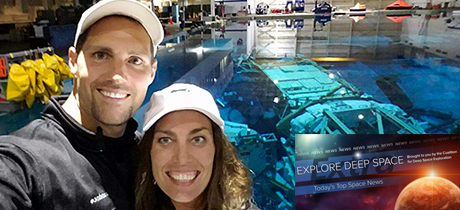In Today’s Deep Space Extra… Florida researcher plans to demonstrate possible strategy for protecting human DNA from space radiation damage during U.S., European undersea experiment.
Human Space Exploration
Mars samples may come to Earth via NASA’s deep space gateway
Space.com (6/9): The lunar orbiting, human tended outpost that NASA plans for the 2020s as a stepping stone to Mars a decade later could serve as a receiving point for samples of soil and rock from the red planet and other planetary bodies awaiting delivery to Earth for study, NASA Acting Administrator Robert Lightfoot told a U.S. House appropriations panel with jurisdiction over NASA on June 8.
ASAP on board with NASA’s DSG as stepping stone to Mars
NASAspaceflight.com (6/9): NASA’s Aerospace Safety Advisory Panel has expressed support for the agency’s Deep Space Gateway, a lunar orbiting, human tended space station planned for the 2020s. The gateway would help to prepare astronauts for the next steps, the human exploration of Mars in the 2030s. The gateway would look to commercial and international partners to advance technologies for missions further from Earth.
USF professor tapped as only non-astronaut for Mars-related research expedition
Tampa Bay Business Journal (6/9): University of South Florida professor Dominic D’Agostino will join a 10 day NASA sponsored undersea space mission simulation to investigate the benefits of ketosis, a metabolic state in which the body burns fat rather than glucose for energy. Ketosis may also protect the body’s DNA from damage due to radiation and other stresses of spaceflight. The expedition begins June 18, six miles off the coast of Key Largo, Fla., at the Florida Keys National Marine Sanctuary as a collaboration between NASA and the European Space Agency.
Xinhua insight: Moon or Mars? Heated discussion on human’s next stop
Xinhuanet of China (6/9): While Mars is a focus of future U.S. human space exploration, the China National Space Administration is talking with the European Space Administration about its future plans, a global moon village. ESA believes the moon is a stepping stone to Mars. Meanwhile, the Japan Aerospace Exploration Agency is assessing both the moon and Mars. Chinese astronauts could be walking on the moon around 2030.
Space Science
NASA selects three teams to fly their cubesats on first SLS mission
Space News (6/9): NASA’s CubeQuest Challenge has selected three teams to develop small satellites for launching aboard NASA’s first Space Launch System flight, currently planned for 2019. The challenge winners are Cornell University, the University of Colorado, Boulder, and Tampa Hackerspace. Cornell’s CisLunar Explorers’ CubeSat, for example, uses electricity to split its water propellant into hydrogen and oxygen, which it burns as fuel. The University of Colorado’s CU-E3 cubesat team designed and prototyped a deployable flat-panel antenna array for high data rate communications. Team Miles has developed a patent-pending, iodine-fueled plasma thruster and software defined radio for the Miles cubesat.
Key building block of life found around young sun-like stars
Space.com (6/10): The young triple star system IRAS 16293-2422, about 400 light years from Earth, has some young sun-like stars as well as some of the chemical building blocks of life, including the complex organic molecule methyl isocyanate. Previously, astronomers detected glycolaldehyde, a sugar linked to the formation of RNA, which is one of the building blocks of life.
MIT students studying mission to asteroid Apophis
SpaceFlightInsider.com (6/10): Twenty MIT students are teaming up to study the near Earth asteroid Apophis with a satellite project that would be launched in August 2016 to carry out Surface Evaluation & Tomography observations of the large asteroid as it approaches in 2029.
Other News
Insider Q & A: From concept to reality, KSC as a multi-user spaceport
Spaceflightinsider.com (6/11): As NASA’s shuttle era came to a close in 2011, the agency’s Kennedy Space Center embraced a new objective — becoming a multi-user spaceport. Two of Kennedy’s executives explain the benefits and challenges of combining private sector space launch activities with those of NASA and the military.
Major Space Related Activities for the Week
Major space related activities for the week of June 11-16, 2017
Spacepolicyonline.com (6/11): Orbital ATK will discuss plans for its next NASA contracted cargo mission to the International Space Station on Monday. Key players in NASA’s now cancelled Asteroid Redirect Mission will address the agency’s Small Bodies Assessment Group at the Goddard Space Flight Center during a meeting set for Monday through Wednesday. Russia plans an early Wednesday launch of its next Progress cargo mission to the International Space Station, MS-06, which will set up a docking two days later.

